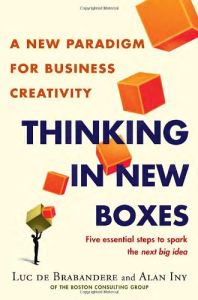Join getAbstract to access the summary!

Join getAbstract to access the summary!
Luc De Brabandere and Alan Iny
Thinking in New Boxes
A New Paradigm for Business Creativity
Random House, 2013
What's inside?
Thinking “outside the box” isn’t enough. Breakthroughs emerge from questioning existing boxes and making new ones.
Recommendation
Whenever a company’s leaders gather to brainstorm innovations, someone will urge the group to “think outside the box.” But that’s not enough, say Luc de Brabandere and Alan Iny of the Boston Consulting Group. You must question your existing “boxes” – the categories into which you place information – and envision new ones. That’s what leaders of the BIC company did when they moved their thinking from one box (making disposable pens) to another (making all sorts of disposable products). Writing in an engaging, conversational style, Iny and de Brabandere outline five steps you can take to achieve more innovative thinking. They follow up with a scenario-planning application that invites you to think about how your company might prepare for an uncertain future. The stakes are high, they write, because companies either drive change or have change happen to them. getAbstract recommends this useful guidebook to corporate leaders at any level seeking fresh ways to spur innovation.
Summary
About the Authors
Former general manager of the Brussels Stock Exchange, Luc de Brabandere is a fellow and senior adviser with the Boston Consulting Group, where Alan Iny is the senior global specialist for creativity and scenarios. Both lead workshops on ideation, building creative capabilities and envisioning the future.


















Comment on this summary